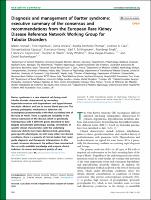| dc.contributor | Vall d'Hebron Barcelona Hospital Campus |
| dc.contributor.author | Konrad, Martin |
| dc.contributor.author | Nijenhuis, Tom |
| dc.contributor.author | Bertholet-Thomas, Aurelia |
| dc.contributor.author | Calo, Lorenzo A. |
| dc.contributor.author | Capasso, Giovambattista |
| dc.contributor.author | Ariceta Iraola, Gema |
| dc.date.accessioned | 2021-07-09T12:29:05Z |
| dc.date.available | 2021-07-09T12:29:05Z |
| dc.date.issued | 2021-02 |
| dc.identifier.citation | Konrad M, Nijenhuis T, Ariceta G, Bertholet-Thomas A, Calo LA, Capasso G, et al. Diagnosis and management of Bartter syndrome: executive summary of the consensus and recommendations from the European Rare Kidney Disease Reference Network Working Group for Tubular Disorders. Kidney Int. 2021 Feb;99(2):324–335. |
| dc.identifier.issn | 1523-1755 |
| dc.identifier.uri | https://hdl.handle.net/11351/6145 |
| dc.description | Bartter syndrome; Inherited hypokalemia; Salt-losing tubulopathy |
| dc.description.abstract | Bartter syndrome is a rare inherited salt-losing renal tubular disorder characterized by secondary hyperaldosteronism with hypokalemic and hypochloremic metabolic alkalosis and low to normal blood pressure. The primary pathogenic mechanism is defective salt reabsorption predominantly in the thick ascending limb of the loop of Henle. There is significant variability in the clinical expression of the disease, which is genetically heterogenous with 5 different genes described to date. Despite considerable phenotypic overlap, correlations of specific clinical characteristics with the underlying molecular defects have been demonstrated, generating gene-specific phenotypes. As with many other rare disease conditions, there is a paucity of clinical studies that could guide diagnosis and therapeutic interventions. In this expert consensus document, the authors have summarized the currently available knowledge and propose clinical indicators to assess and improve quality of care. |
| dc.language.iso | eng |
| dc.publisher | Elsevier |
| dc.relation.ispartofseries | Kidney International;99(2) |
| dc.rights | Attribution-NonCommercial-NoDerivatives 4.0 International |
| dc.rights.uri | http://creativecommons.org/licenses/by-nc-nd/4.0/ |
| dc.source | Scientia |
| dc.subject | Assistència sanitària - Control de qualitat |
| dc.subject | Ronyons - Malalties - Diagnòstic |
| dc.subject | Malalties rares |
| dc.subject.mesh | Bartter Syndrome |
| dc.subject.mesh | /genetics |
| dc.subject.mesh | Quality Indicators, Health Care |
| dc.subject.mesh | Diagnostic Techniques and Procedures |
| dc.title | Diagnosis and management of Bartter syndrome: executive summary of the consensus and recommendations from the European Rare Kidney Disease Reference Network Working Group for Tubular Disorders |
| dc.type | info:eu-repo/semantics/article |
| dc.identifier.doi | 10.1016/j.kint.2020.10.035 |
| dc.subject.decs | síndrome de Bartter |
| dc.subject.decs | /genética |
| dc.subject.decs | indicadores de calidad en la asistencia sanitaria |
| dc.subject.decs | técnicas y procedimientos diagnósticos |
| dc.relation.publishversion | https://linkinghub.elsevier.com/retrieve/pii/S0085253820314046 |
| dc.type.version | info:eu-repo/semantics/publishedVersion |
| dc.audience | Professionals |
| dc.contributor.organismes | Institut Català de la Salut |
| dc.contributor.authoraffiliation | [Konrad M] Department of General Pediatrics, University Hospital Münster, Münster, Germany. [Nijenhuis T] Department of Nephrology, Radboud University Medical Center, Nijmegen, The Netherlands. [Ariceta G] Servei de Nefrologia Pediàtrica, Vall d’Hebron Hospital Universitari, Barcelona, Spain. Universitat Autònoma de Barcelona, Bellaterra, Spain. [Bertholet-Thomas A] Université Claude Bernard Lyon 1, Lyon, France. [Calo LA] Department of Medicine (DIMED), Nephrology, Dialysis, Transplantation, University of Padova, Padua, Italy. [Capasso G] Division of Nephrology, Department of Translational Medical Sciences, School of Medicine, University of Campania "Luigi Vanvitelli", Naples, Italy |
| dc.identifier.pmid | 33509356 |
| dc.identifier.wos | 000661641000001 |
| dc.rights.accessrights | info:eu-repo/semantics/openAccess |

